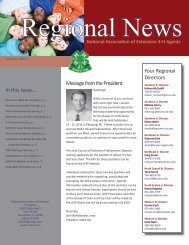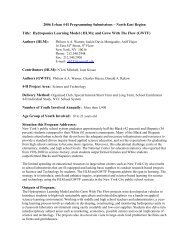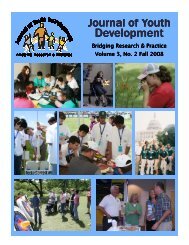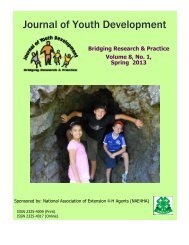Winter 2008 - Vol. 3 No. 3 - National Association of Extension 4-H ...
Winter 2008 - Vol. 3 No. 3 - National Association of Extension 4-H ...
Winter 2008 - Vol. 3 No. 3 - National Association of Extension 4-H ...
- No tags were found...
Create successful ePaper yourself
Turn your PDF publications into a flip-book with our unique Google optimized e-Paper software.
easons given was six. Sixty-three percent <strong>of</strong> the students gave at least one internal reason fornon-participation and 67% <strong>of</strong> the students gave at least one external reason for nonparticipation.Finally, 30% <strong>of</strong> the students gave both internal and external reasons for nonparticipation.Withdrawal interviews indicated that there were six primary reasons that students dropped out<strong>of</strong> the after-school program as listed in Table 3.Table 3Top Six Reasons for Withdrawal, N=70Reason givenPercentage <strong>of</strong> students who gaveparticular reason1) Engagement in other non-family oriented27%after-school activities (i.e. dance club)2) Lack <strong>of</strong> program fidelity 21%3) Engagement in family-related, after-school18%activities (i.e. babysitting siblings)4) Program was too long 17%5) Boredom 16%6) Need for more academic help 15%In Weisman and Gottfredson’s 2001 study, the main reason students gave for dropping out <strong>of</strong>the program was boredom. Boredom, however, was cited by only 16% <strong>of</strong> the dropouts in thisstudy. Fifteen percent <strong>of</strong> the dropouts stated that they needed more academic help. Studentsin this category expressed concern over the lack <strong>of</strong> help in subject areas such as language arts,math, and reading – areas that they were struggling with in school. Moreover, a fraction <strong>of</strong>these students were actually taken out <strong>of</strong> the after-school program and placed in specializedtutoring programs in order to obtain the help they needed. Although “homework help” was aprogram component sometimes performed alongside tutoring, the majority <strong>of</strong> students in thisgroup stated that homework help was either not given and/or was not sufficient for theirparticular assignments. A few <strong>of</strong> the students voiced their concerns over the inability <strong>of</strong> tutorsand/or program staff to actually help them complete their homework because as one particularstudent stated, “they [the program staff] didn’t know how to do it.” This suggests that programstaff members were not sufficiently trained to assist a student in completing their particularhomework assignments. Altogether, more dropouts indicated that various aspects <strong>of</strong> the afterschoolprogramming (i.e. concerns listed under program complaints) caused them to drop out(as opposed to the external issues).SummaryThis study found more participant concern regarding the internal workings <strong>of</strong> the program(internal issues) than external issues. The top six reasons for non-attendance in the ASP were:1. Engagement in non-family-related after-school activities,2. Lack <strong>of</strong> program fidelity,3. Engagement in family-related after-school activities,4. Program length,






